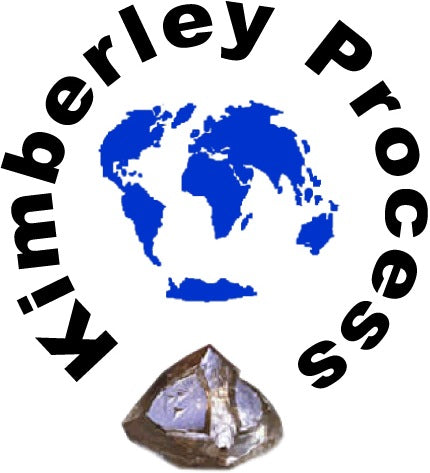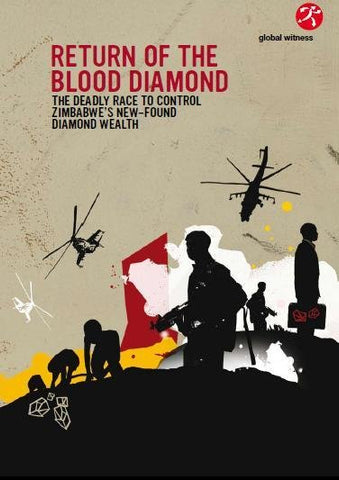If you’ve come to our site, chances are you’re looking for an ethically sourced and alternative style diamond or sapphire. Perhaps you want to make sure that our diamonds are conflict-free and Kimberley Certified, because you assume that this means the diamonds are ethically sourced. Though all our diamonds are 100% conflict-free and Kimberley certified, we have to go above and beyond the Kimberley Process in order to comfortably assure our customers that our diamonds are, in fact, responsibly sourced.

This brings us to covering a difficult topic that we alluded to in a previous post about our responsible sourcing methods. We’d like to discuss the Kimberley Process and why we feel that it is ineffective and needs to be overhauled. First and foremost, we adhere closely to the Kimberley Process because US law mandates that all rough diamonds that are not mounted or set must be imported or exported with a Kimberley Certificate.
HISTORY OF THE KIMBERLEY PROCESS
In 2000, after many years of civil war in Angola where rebel groups used proceeds from the diamond trade to finance their wars, the United Nations Security Council deemed rough diamonds that were exported from Angola to be blood diamonds, and imposed sanctions. Other African diamond producing countries decided to secure themselves from future sanctions by the UN by creating what is now known as the Kimberley Process. The Kimberley Process Certification Scheme (KPCS) was originally put in place in 2003 under a mandate by the UN General Assembly. Under the Kimberley Process, the definition of a conflict diamond was created along with an onerous certification process, and thus the KPCS served to assure the general market that rough diamonds that fall under the scheme are not conflict diamonds. Today, every significant diamond producing nation in the world has been accepted to the Kimberley Process. This means that every diamond produced today is considered conflict free according to the Kimberley definition. Currently, the only clear role of the KPCS is to hold in place a strict set of rules that require all member countries to write certificates for all rough diamond exports.
REDEFINING CONFLICT
The KPCS defines a conflict diamond as a diamond that finances “violence by rebel movements and their allies seeking to undermine legitimate governments”. The definition of a conflict diamond excludes an important statement – that a conflict diamond should also be defined as one that finances violence by established governments themselves against civilians. In fact, the current definition of a conflict diamond allows diamond producing countries that are carrying out ethnic cleansing or other violent crimes against their own civilians to claim that their diamonds are conflict-free and thus the general public sees these diamonds as “ethical” and “responsible”.
A LAW THAT CANNOT BE CHANGED
The Kimberley Process has a consensus rule that any member country can veto any changes made to the Kimberley Process Certification Scheme. With this veto system in place, no impactful changes of the Kimberley Process will happen. Why? Because the Kimberley Process has accepted every significant diamond producing nation in the world into its membership, excluding only the countries that cannot afford to put the costly process in place. This means that, essentially, all diamond producing nations that are members of the Kimberley Process will continue to block changes to the process in order to serve their own interests.
ZIMBABWE AS EXAMPLE
Between 2008 and 2012, Zimbabwe was found to have been using the diamond trade as a means for funding a corrupt government regime (not a rebel group) that was carrying out crimes against humanity. The infamous Marange Diamond Fields is a region in Zimbabwe that is rich in diamond deposits. During this time, military officers overtook the mines, killing at least 200 workers in the process, then forced local villagers to carry out the mining tasks. Villagers were beaten, tortured, killed, and received little or no pay for their work. The Marange Diamond Fields are also known as the Marange Killing Fields because it is within this area that the government also carried out terrible crimes against its citizens. The Kimberley Process officials, after on-the-ground observation of the situation in Zimbabwe, concluded that the diamonds that came from the Marange Diamond Fields be deemed conflict-free and sold under the Kimberley Process internationally because the definition of a conflict-free diamond does not include when the government uses the diamond trade to finance violence against its own citizens. At this announcement, one of the founding NGOs of the Kimberley Process – Global Witness – withdrew their involvement from the Kimberley Process and deemed it ineffective. Zimbabwe diamonds continue to be traded in the world markets as conflict-free.
Image courtesy of Global Witness
A LOGISTICAL NIGHTMARE
The logistics involved in shipping a conflict-free diamond from one Kimberley Process member country to another is as follows: the rough diamonds are brought to a government office, the government office fills out a unique Kimberley Certificate stating that the rough diamonds are conflict-free, the shipper pays a government mandated fee for the Kimberley certificate and then exports the rough diamonds. The diamonds are checked in customs and the Kimberley certificate is reviewed for authenticity. The diamonds are then imported. A copy of the Kimberley Certificate must be kept by the shipper and receiver for 3 years, and they may receive periodic audits. No one checks where the rough diamonds came from originally, not that it matters as virtually all diamond producing nations are accepted by the Kimberley Process anyway. So, a certification scheme is in place to certify everything. In addition, there are countries that are members of the Kimberley Process that have no diamond mines at all, nor would be considered by anyone as a conflict nation. The logistics and paperwork of the KPCS are especially wasting valuable time and money in places like these.
FAILURE IS SUCCESS
As is, the Kimberley Process represents a flipped paradigm, where success is failure and failure is success. After international news about blood diamonds was taking over the airways in the early 2000s the diamond producing nations saw that they were going to be policed eventually. Instead of allowing an outside group do this, they initiated the KPCS themselves and made a foolproof plan to continue to sell their diamonds and also call them “conflict-free” without needing to make any changes to their government actions. Again, in some of these countries, it is the government itself that carries out crimes against humanity, not “rebel groups”. Yet, because the definition of a conflict diamond by the KPCS and the lack of an effective voting process, a diamond that benefits a government that is killing its own people is thus deemed conflict-free and is sent on to be sold to consumers around the world.
OPPORTUNITIES FOR CHANGE
The Kimberley Process should be given the opportunity to evolve, with clear steps to follow for its evolution, including first the expansion of the definition of a conflict diamond, second, a change in the veto system, and third, the limiting of paperwork required by member countries that are at no risk of acting as a conflict nation. If the KPCS does not evolve, as we believe it will not, then it should be dismantled over time and replaced by a better system. A new system would include the above, without the current system of paperwork at all. Instead, the system would focus on finding where there are inconsistencies in data between, for example, official government exports of rough diamonds and actual diamond production to crack down on illegal trafficking. Countries that have a history of conflict or human rights abuses should be continually observed and have greater oversight and stricter requirements than other countries, including continual inspection of mines, certification processes that begin at the mines with a third-party inspector providing oversight, and sanctions to encourage the country to comply – such as immediate removal from the process and refusal of member countries to participate in the diamond trade with that country until it complies. There are a number of other options to improve the oversight of the diamond trade, but we believe that these are crucial first steps.
ABOVE THE KIMBERLEY PROCESS
In the meantime, here at The Raw Stone we are doing our very best to go above and beyond the Kimberley Process to actually provide responsibly sourced rough diamonds and other gemstones to our customers. If you are concerned about buying something for yourself or your loved one that doesn’t cause suffering of another human, then here’s why buying from The Raw Stone is better than just getting a Kimberley Certificate.
To check out our full collection of rough diamonds, click here. Or email us directly with any questions or requests at info@therawstone.com


0 comments